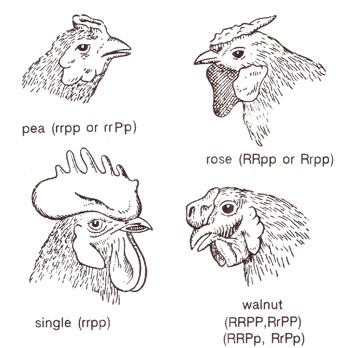Two gene pairs affecting same character
In the last topic, dihybrid ratio was considered where the two genes were independently controlling separate characters. Therefore, there was independent assortment of the genes as well as of the characters. In case of comb shape in poultry, two genes are responsible for this character. While one gene gives rise to rose comb, another gives rise to pea comb. Each of these two is dominant over single comb. However, when both are brought together, a new phenotype walnut appears (Fig. 3.2).
As worked out by W. Bateson and R.C. Punnett, when both dominant alleles are present, walnut phenotype appears and when both recessive alleles are present single comb appears. Rose and pea phenotypes each appears due to the presence of different but single dominant alleles. If pea (rrPP) and rose (RRpp) are crossed or if walnut (RRPP) and single (rrpp) are crossed, the F1 individual in both cases will have walnut phenotype and will be heterozygous for both genes (RrPp). These individuals when crossed among themselves will give four phenotypes in 9 : 3 : 3 : 1 ratio (Table 3.2).
It should be realized that this 9 : 3 : 3 : 1 ratio is different from the one given in the last topic, because there it represents four combinations of two pairs of characters, while in this example they represent four phenotypes of the same character.






